First international wireless message Bristol Channel |
| Mahlom Loomis | Marconi and the Bristol Channel | Marconi and the transatlantic wireless | Epilogue and sources |
Guglielmo Marconi Marconi was born on April 25, 1874, in Bologna (Italy) the son of a wealthy Italian businessman, Giuseppe Marconi and a younger Irish woman, Anna Jamieson. Marconi showed an early interest in physics and electricity. In 1894 he began experimenting in the use of radio waves to send messages without the use of wires (hence the term "wireless"), progressively increasing the distance over which a message could be transmitted: across a room, down a corridor, the length of a field. In 1896, he left Italy and he took his equipment to England where he was granted the first patent for a system of telegraphy. Marconi first conducted demonstrations on Salisbury Plain in September 1896, in front of GPO, Army and Admiralty Officials, where he achieved ranges consistent with his work at the Villa Griffone (Italia). He used parabolic reflectors and the distance covered was extended to 2.5km. As soon as his British Patent No 12039 was published on 2 March 1897, he was accused by some observers of plagiarising the work of an English physicist, Professor Oliver Lodge, but overall the reaction was favourable. Henry Jameson-Davis, his cousin was now assured of the viability of starting a company to exploit the patent, whenever Marconi was ready. Over the next five years he continued to push back the boundaries of radio transmission. |
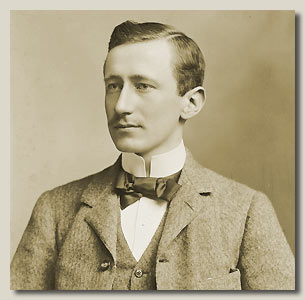 |
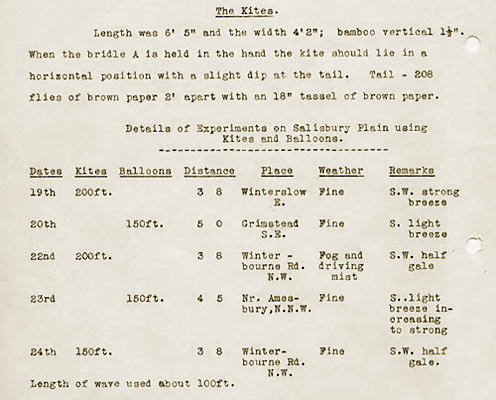 |
The Bristol Channel was the site of experiments in wireless communication between Lavernock in South Wales and Brean Down in Somerset by Marconi during may 1897. Marconi set a new distance record of 8.7 miles. Recruitment of trained scientists followed and George Kemp was persuaded to join the company as 'chief assistant' of Marconi. In the extract of George Kemp's diary he gives an account of the Bristol Channel experiments. His account begins on the 6th May 1897; 'Left Paddington for Cardiff and then on to Lavernock to see the mast and found that a long cable had been fixed, which stretched out beyond low water mark, for the purpose of earth connection.' |
|
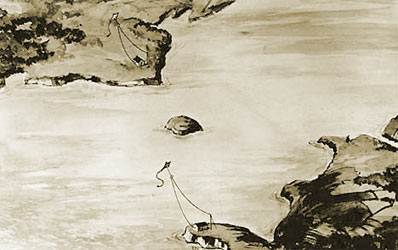 |
||
| A drawing by George Kemp, which refers to the Bristol Channel experiments |
||
The diary includes a day to day account of the experiments and performance of the apparatus. Kemp describes further experiments and successes and ends his account with a full description of the kites, balloons and a table summarising the final days' experiments. (table above) |
||
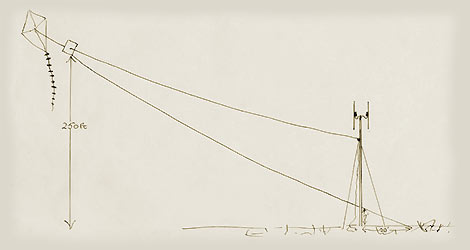 |
The drawing which relates to the experiments between Lavernock and Bream Down shows the method by which an increase in distance from 3 miles to 8 miles was obtained. For these experiments kites, covered with tin foil and flown at a considerable height, were used as aerials. 20 July 1897, the Wireless Telegraph and Signal Company was founded. In October 1897 Marconi nearly doubled his previous best distance by linking Bath and Salisbury, 34 miles aprt, by hoisting aerials by kites and balloons and assisted by George Kemp On the left, one of the five drawings taken from the diary of George Kemp. They were drawn during the period of the Bristol Channel Experiments and seem to be a set of sketches offering different methods and solutions of raising an aerial with the use of either a kite or balloon for raising the height of the aerials to increase reception range during the experiments. |
In September 1898, the Company asked the French Government for permission to construct a wireless station on their side of the English Channel. A wireless station was set up at Wimereux, near Boulogne, and on 27 March the first international wireless message was transmitted to the South Foreland |
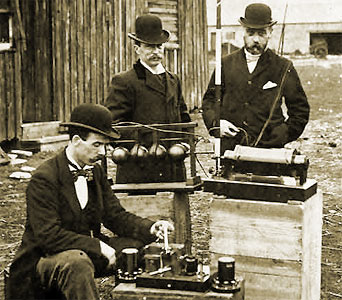 |
Station (near Dover) on the English coast, at 85 miles from France, by transmitting a triple `V' for victory. |
|
A was written by Agnes Baden-Powell to Marconi to congratulate him on this success: " Will you allow me to congratulate you warmly on the grand success you have achieved, in actually bridging the Chanel. It is a splendid triumph, not withstanding the presence of a group of French sceptics. My Mother and I will be here for a fortnight and we hope very much that you will allow us the pleasure of seeing you if you should come to Bournemouth, where we can tell you how much we appreciate the wonders you have accomplished, for the progress of science." |
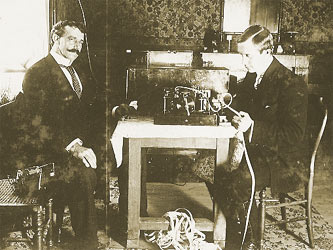 |
|
Kemp seated with Marconi at Wimereux |
||
Post Office officials with Marconi's apparatus at the Bristol Channel demonstration |
||
In 1899 Marconi was in New York to supervise the arrangements for reporting of the America Cup yacht race on behalf of the New York Herald and Evening Telegram newspapers. 22 November 1899: Marconi Wireless Telegraph Company of America is registered 26 April 1900, the '7777' patent that states Marconi to be 'true and first inventor' related solution to the issue of mutual interference. |